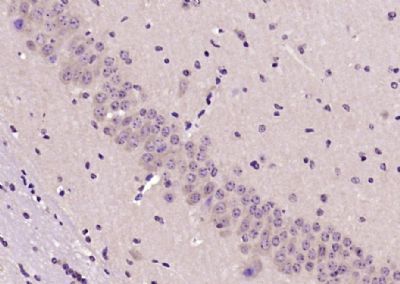产品货号 : mlR22137
英文名称 : LPA1
中文名称 : 溶血磷脂酸受体蛋白1/EDG2抗体
别 名 : EDG 2; Endothelial Cell Differentiation Gene-2; Endothelial differentiation gene 2; Endothelial Differentiation Lysophosphatidic Acid G Protein Coupled Receptor 2; G10 protein homolog; GPCR 26; GPCR26; Gpcr91; Kdt2; LPA 1; LPA receptor 1; LPA receptor EDG2; LPA1; LPAR1; Lysophosphatidic acid receptor 1; Lysophosphatidic acid receptor EDG2; MGC105279; MGC29102; LPAR1_HUMAN.
研究领域 : 肿瘤 免疫学 信号转导 G蛋白偶联受体
抗体来源 : Rabbit
克隆类型 : Polyclonal
交叉反应 : Human, Mouse, Rat, Dog, Pig, Cow, Rabbit, Sheep,
产品应用 : IHC-P=1:400-800 (石蜡切片需做抗原修复)
not yet tested in other applications.
optimal dilutions/concentrations should be determined by the end user.
分 子 量 : 41kDa
细胞定位 : 细胞浆 细胞膜
性 状 : Lyophilized or Liquid
浓 度 : 1mg/ml
免 疫 原 : KLH conjugated synthetic peptide derived from human LPA1:1-50/364 <Extracellular>
亚 型 : IgG
纯化方法 : affinity purified by Protein A
储 存 液 : 0.01M TBS(pH7.4) with 1% BSA, 0.03% Proclin300 and 50% Glycerol.
保存条件 : Store at -20 °C for one year. Avoid repeated freeze/thaw cycles. The lyophilized antibody is stable at room temperature for at least one month and for greater than a year when kept at -20°C. When reconstituted in sterile pH 7.4 0.01M PBS or diluent of antibody the antibody is stable for at least two weeks at 2-4 °C.
PubMed : PubMed
产品介绍 : EDG2 belongs to a family of G-protein coupled receptors whose ligands are lysophospholipids. There are eight known members of the EDG receptor family and they are implicated in mediating growth-related effects such as induction of cellular proliferation, alterations in differentiation and survival, and suppression of apoptosis. They also evoke cellular effector functions that are dependent on cytoskeletal responses such as contraction, secretion, adhesion and chemotaxis. EDG receptors are developmentally regulated and differ in tissue distribution. They couple to multiple types of G proteins to signal through ras and MAP kinase, rho, phospholipase C, and several proteins not used within 12 hours. Edg2 has been reported in most human tissues, and is especially abundant in brain cortical regions. ESTs have been isolated from bone, brain, breast, connective tissue, embryo, heart/melanocyte/uterus, lung, prostate and uterus libraries.
Function:
Receptor for lysophosphatidic acid (LPA), a mediator of diverse cellular activities. Seems to be coupled to the G(i)/G(o), G(12)/G(13), and G(q) families of heteromeric G proteins. Stimulates phospholipase C (PLC) activity in a manner that is dependent on RALA activation.
Subunit:
Interacts with RALA and ADRBK1.
Subcellular Location:
Cell surface. Cell membrane; Multi-pass membrane protein. Note=Prior to LPA treatment found predominantly at the cell surface but in the presence of LPA co-localizes with RALA in the endocytic vesicles.
Tissue Specificity:
Expressed in many adult organs, including brain, heart, colon, small intestine, placenta, prostate, ovary, pancreas, testes, spleen, skeletal muscle, and kidney. Little or no expression in liver, lung, thymus, or peripheral blood leukocytes.
Similarity:
Belongs to the G-protein coupled receptor 1 family.
SWISS:
Q92633
Gene ID:
1902
Important Note:
This product as supplied is intended for research use only, not for use in human, therapeutic or diagnostic applications.
产品图片












